
Feature Article
Food Safety of Food Banks and Community Kitchens
In Hong Kong, there are food recovery programmes such as food banks and community kitchens, which are usually operated by non-governmental organisations to provide food assistance to people in need (Figure 1). These programmes also help reduce food waste. Food banks and food pantries collect and redistribute donated food, while community kitchens are often involved in food processing such as handling, re-heating and cooking. Regardless of how donated food is recovered, it must be fit for human consumption. This article briefs the public on food safety concerning the operation of food banks and community kitchens, recommends measures for safeguarding food safety and provides advice on the handling of collected food.
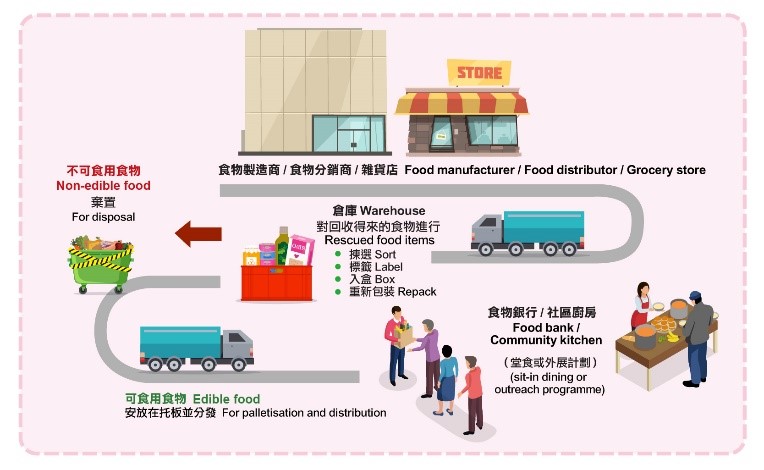
Figure 1. How community kitchens and food banks receive food from different sources and redistribute it to people in need.
Proper Inventory Inspection and Management for Food Recovery
As food recovery organisations collect donated food from multiple sources like charities and food companies, the quality of the food often varied, which may cause food safety concerns. Prepackaged food received may have passed its “use by” date, while non-prepackaged food may have been damaged or spoiled. If not stored properly, collected food may also go bad. Therefore, before receiving donated food and building up an inventory, it is important to check whether the food is stored according to the manufacturers’ instructions or kept at suitable temperatures.
Prepackaged food should be checked for irregularities in packaging, such as cracks on bottles or tears on bags (Figure 2), and properly labelled with information like expiry dates, allergens and storage instructions. For non-prepackaged food, such as fresh meat and produce, only wholesome items should be accepted. In general, mouldy and rotten food items or items with excessive bruises should not be accepted.
Collected food should be stored properly in a hygienic and pest-free environment and in accordance with the storage instructions before redistribution. Do not redistribute food that is beyond the “use by” dates. Expiry dates only apply to unopened products. Perishable food should be kept in the refrigerator at or below 4°C, while frozen food should be kept in the freezer at or below -18°C. Shelf-stable food item such as canned food and cereals should be kept in a cool, dry place.
It should be noted that the first-in-first-out principle may not be applicable in the food banks setting because the same product may have come from various sources with different expiry dates. Expiry dates are essential information on inventory records to facilitate timely outgoing transactions and avoid wastage. Thus, food banks should keep track of their inventory records not only for inventory management but also for traceability.
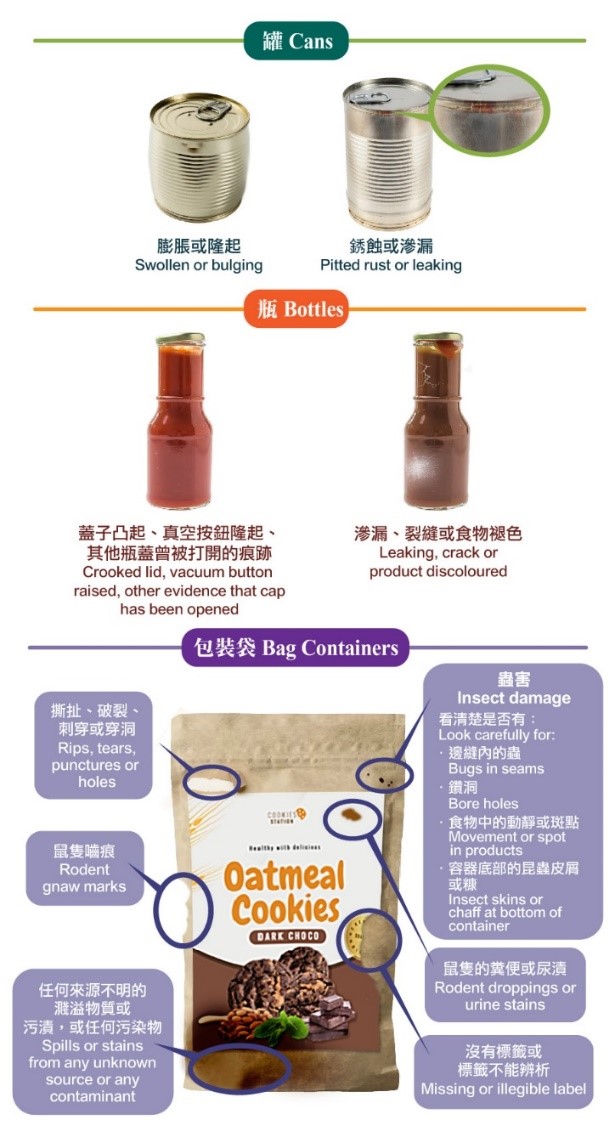
Figure 2. Examples of common irregularities of prepackaged food items
Ensure Safe Food Preparation in Community Kitchens
Donated food can be further processed in community kitchens, which provide space where individuals or groups can come together to prepare and cook food. Cooking classes, nutrition education or other services may also be offered at these kitchens to help individuals and families improve their food literacy and cooking skills.
As meals prepared and served in community kitchens are usually consumed on-site or delivered to groups in need in the form of meal boxes, if handled improperly, they may lead to foodborne illnesses. To prevent this, food handlers working in community kitchens should receive appropriate training in food safety and maintain good personal, environmental and food hygiene at work. Food handlers and operators of community kitchens should always observe Good Hygiene Practices (GHPs) and Five Keys to Food Safety in the food production and recovery processes.
Meals prepared in community kitchens are usually meant to be eaten right away without further cooking or preparation and therefore should be consumed as soon as possible. If not to be consumed immediately or for transportation, hot food should be kept hot at above 60°C while cold food should be kept cold at 4°C or below as far as possible. Chilled food should not be reheated more than once and should be reheated thoroughly before serving. All prepared meals that have been held at room temperature for more than four hours should be discarded.
The primary goal of a community kitchen is to promote social interaction, encourage the public to develop a healthy eating habit and provide nutritious food for individuals and families who do not have the resources or ability to prepare meals on their own. Generally speaking, it is very important to ensure food safety in these community kitchens to prevent foodborne illnesses.
Mascot ON in Lesson
Food Safety Day 2023 - Prevent Food Poisoning at Home with 5 Keys!
Foodborne illnesses are largely preventable and can be significantly reduced if we raise our awareness of food safety and take action accordingly. The World Food Safety Day (WFSD), cerebrated on 7 June, is an annual event jointly organised by the Codex Alimentarius Commission (Codex), Food and Agricultural Organization (FAO) and the World Health Organization (WHO) of the United Nations with a view to promoting food safety.
This year, in support of the WFSD, the Centre for Food Safety (CFS) promoted Five Keys to Food Safety (5 Keys) on the Food Safety Day 2023 to enhance food safety practices at home, and to raise public awareness that foodborne illnesses can be prevented and the risk of contracting antimicrobial-resistant microorganisms can be reduced simply by taking simple actions. Through social media posts and a short video, the CFS aimed to enhance public understanding of the 5 Keys, which include storing food at safe temperatures, cooking and reheating food thoroughly to prevent food poisoning, keeping hands and utensils clean, and separating raw food and cooked food. For details, please visit the CFS’s Facebook or Instagram pages.
Eating Fish from Local Wet Markets Raw - Is It Safe?
At times, some people share recipes online that contain raw fish from local wet markets, arousing questions about food safety. Most fish sold in wet markets are not intended for raw consumption. The microbiological risks of consuming raw fish, for example the infection of harmful bacteria, viruses and parasites, should not be overlooked. Besides, condiments like soy sauce, chilli sauce and wasabi cannot kill the foodborne pathogens that may be present in raw fish.
To ensure food safety, food businesses and the public should purchase raw materials from reputable and reliable sources for preparing dishes. When purchasing food for raw consumption such as sashimi, consumers are advised to check whether the food premises hold valid food business licences or permits for the sale of such restricted food. Food not intended to be eaten raw should be cooked thoroughly before consumption.
Dining Out
Should We Worry about Preservatives and Antioxidants in Food – Or Should We Not?
Imagine there are no preservatives and antioxidants. Consumers may be offered less choice of foods because many processed foods contain these additives. Some common examples are luncheon meat, bacon, margarine, sauces, bread, juice, snacks, etc. Many people, however, may not be aware that some foods, because of their nature, require the use of preservation techniques to help maintain their safety and freshness. To meet the needs for a safe, convenient and stable supply of food, preservatives and antioxidants are getting ever more indispensable.
Why are Preservatives and Antioxidants Added to Food?
The history of food preservation can be traced back to the ancient times, when sugar was used to preserve fruit and salt was used to preserve meat to keep harvested food edible over a longer period of time. While some may find preservatives and antioxidants similar, they perform distinct functions in foods by combating two major enemies of our foods, microbes and oxidation, respectively.
Preservatives prevent the spoilage of foods by inhibiting the growth of microbes. Harmful bacteria can invade our foods and, if consumed, can make us critically ill. Clostridium botulinum, for example, produces a very potent neurotoxin that can cause life-threatening botulism. Preservatives can inhibit the growth of this bacterium in the manufacturing of food such as cured meat. Other microbes like fungi and yeasts can also cause food spoilage and produce toxins that are harmful to our health. Therefore, in addition to maintaining the quality of foods, the use of preservatives is particularly important to preventing foodborne illnesses.
Antioxidants, on the other hand, protect foods against deterioration caused by oxidation. When foods are exposed to oxygen in the air, oxidation may occur and cause undesirable changes in the flavour and colour of foods. This is where antioxidants come into play to prevent fats and oils from turning rancid and developing an unpleasant off-flavour, as well as slow down the discolouration of fruit and vegetables.
In recent years, food production has undergone tremendous advances, largely driven by consumer demands and globalisation. Large-scale, cross-border food processing is an important part of the global food supply chain. Food additives are used to help ensure that processed food stays safe and in good condition during its journey from processing plants in one part of the world to the hands of faraway consumers in yet another part of the world. Without preservatives and antioxidants, people would have fewer food options, many foods would be more expensive, more people would not have sufficient access to safe food, and more food would be wasted. More importantly, many people might get sick from the consumption of spoiled food.
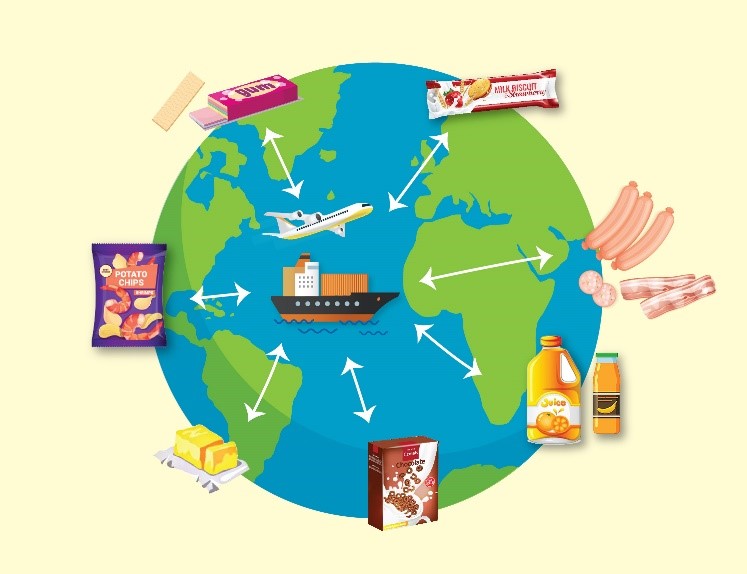
Figure 3: Preservatives and antioxidants help ensure processed food remains safe and in good condition throughout its journey from one part of the world to consumers in another part of the world
Are Preservatives and Antioxidants Safe for Consumption?
Despite their benefits in improving food safety and reducing food waste, preservatives and antioxidants are permitted for use in food only after they have undergone stringent safety evaluation and are found not to present an appreciable health risk to consumers at the levels of use. At the international level, the safety evaluation is made by the Joint FAO/WHO Expert Committee on Food Additives (JECFA), and food additive standards are developed by the FAO/WHO Codex based on sound scientific principles with a view to protecting the health of consumers and ensuring fair international food trade.
How are Preservatives and Antioxidants Regulated in Hong Kong?
In Hong Kong, the Preservatives in Food Regulation (Cap. 132BD) specifies the types of permitted preservatives and antioxidants and their maximum permitted levels in specified foods.
In addition, food manufactures should follow Good Manufacturing Practice and apply preservatives and antioxidants in food in a way that only the minimum amount is added to achieve the desired technological effect.
How to Make an Informed Choice?
Consumers can make an informed choice and check if preservatives and antioxidants are present by reading the ingredient list on the food packaging. According to the Food and Drugs (Composition and Labelling) Regulations (Cap. 132W), if a food additive, including preservatives and antioxidants, is used in a prepackaged food, it must be listed by its functional class together with its specific name or identification number in the ingredient list on the food label.
Healthy Eating Basics and Smart Food Choices
Healthy Eating Basics
How to Interpret the Test Report on Preserved Vegetables
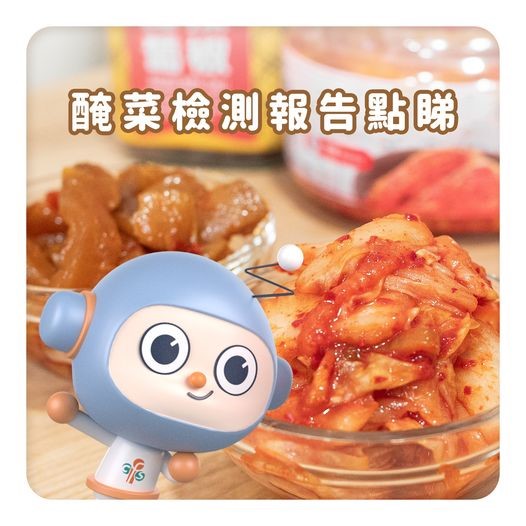
Many people know that preserved vegetables are high in sodium (salt) content and eating too much of them is no good. An organisation collected 30 samples of prepackaged preserved vegetables (including kimchi, sauerkraut, cucumber, preserved mustard tuber, radish and vegetable with olive) on the market for chemical, light filth and nutrient tests.
Listen To Our Mascots:
- Nitrate and nitrite, which naturally exist in vegetables, are used to produce protein essential for the growth of vegetables. They are not contaminants. In general, their contents will not pose a risk to public health.
- Light filths are extremely tiny foreign substances only visible after being magnified under the microscope. The CFS only found a piece of suspected insect fragment with a length of 0.5 mm in a follow-up sample of one of the products, and follow-up action has been taken. No foreign substance (e.g. metals, stone chips, plastic fragments, etc.) was detected in the remaining samples.
- In the past two years, the CFS collected more than 2,100 samples of preserved vegetables for testing, and the preservative test results of two samples were unsatisfactory. The CFS has announced the results to the public and taken appropriate follow-up action.
- The organisation referred three cases involving food labelling and nutrient labelling to the CFS for follow-up. The CFS found that two products were no longer put on the market, and that the preservative declaration of the other one did not meet the relevant statutory requirement. The CFS has taken appropriate follow-up action.
A Reminder On Food Safety:
- Most preserved vegetables are marinated with salt and are considered high in sodium content. When purchasing prepackaged food, the public should read the nutrient labels and choose products with a lower sodium content.
- It is the responsibility of the trade to review and further improve their food manufacturing process, in order to minimise the possibility of mixing insect fragments into the food.
Smart Food Choices
Prawns and Greens in Pumpkin Purée
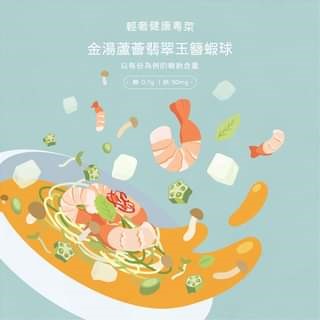
The Chinese name of “Prawns and Greens in Pumpkin Purée” is beautiful and so does the presentation of the dish! With prawns and vegetables such as asparagus, pumpkin, okra, etc. as ingredients, the dish not only looks colourful but also has a refreshing taste, breaking through the traditional stereotype of Cantonese cuisine as greasy and strong in taste. There is no reason not to share such a healthy and delicious “3 Low” dish with your family. Tonight, you will have the chance to show your culinary skills!
If you want to know the ingredients, seasonings and steps for preparing this dish, go and visit this webpage of the EatSmart Restaurant Star+ of the Department of Health:
https://restaurant.eatsmart.gov.hk/eng/content.aspx?content_id=1224
News on CFS
1. Enhanced Exchanges on Food Safety between Hong Kong and Macao
To enhance interaction and exchanges on food safety work between Hong Kong and Macao, representatives from the Department of Food Safety of the Municipal Affairs Bureau of the Macao Special Administrative Region participated in the 81st meeting of the Trade Consultation Forum held by the CFS on 23 June 2023.

The CFS also arranged an experience sharing session after the forum for representatives from both sides to gain a deeper understanding of each other's daily operations in respect of risk communication and food import and export control. The CFS hoped that through close communication and co-operation, both sides would exchange information on food safety more effectively and safeguard food safety together.
2. The 81st Meeting of the Trade Consultation Forum
The 81st meeting of the Trade Consultation Forum was held on 23 June 2023. The CFS and the trade exchanged their views on topics including “Salt Iodisation – A Practical Guide for Salt Importers/Wholesalers/Retailers”, “Implementation of the New Arrangement for Extension of Fresh Food Imported via Hong Kong-Zhuhai-Macau Bridge”, “Safety Assessment of Cultured Meat”, “Export of Food to the Mainland” and “Import Control of Japanese Food”. For details of the event, please visit the following website:
https://www.cfs.gov.hk/english/committee/Notes_and_Presentation_Materials_TCF81_20230623.html
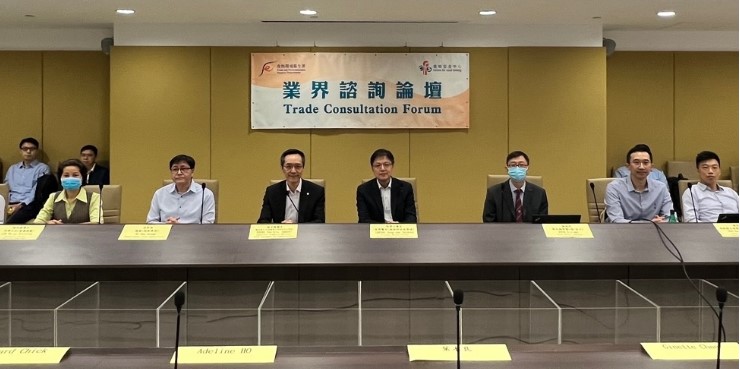
3. CFS's Distribution of Newly Compiled Food Safety Guidelines on Ready-to-eat Foods to Restaurants
In early July 2023, health inspectors of the CFS distributed newly compiled food safety guidelines on ready-to-eat foods to restaurants. The new guidelines cover local ready-to-eat foods such as siu mei and lo mei. To enhance restaurant staff’s understanding of the new guidelines, health inspectors also explained to them the guidelines on the spot and reminded them of the necessary food safety measures for the production of ready-to-eat foods such as siu mei and lo mei.
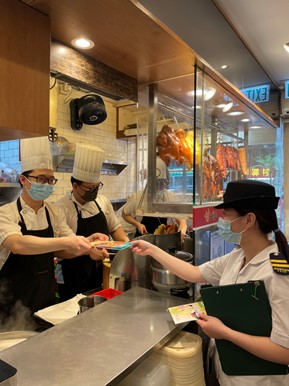
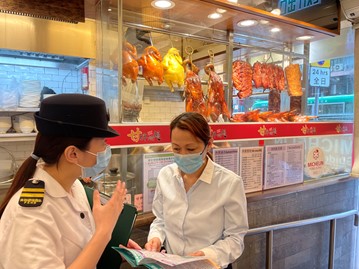
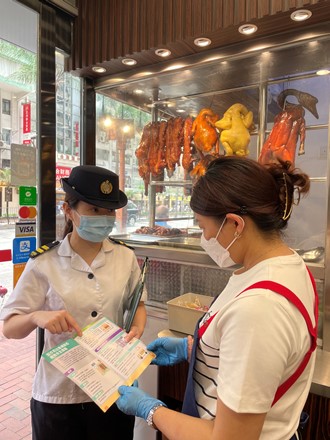
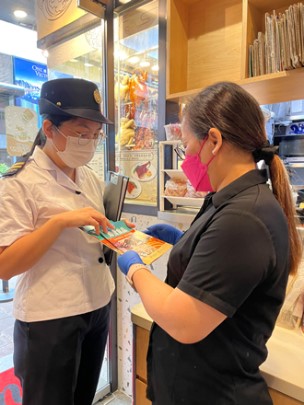
4. “Safe Food at School” Webinar Organised by CFS
Since the resumption of whole-day face-to-face classes, the CFS has stepped up its territory-wide inspections of licensed food factories which supply school lunch boxes with a view to ensuring food safety. To prepare for the start of the new school term, the CFS held on 28 July 2023 an online talk for primary schools, highlighting food safety hazards such as choking and food allergies that school staff and food handlers should pay attention to. In addition, an online trade meeting was held on 2 August 2023 to remind lunch box suppliers to adhere to GHPs in food preparation and establish a food safety plan based on the Hazard Analysis and Critical Control Point system to lower the risks of food contamination.

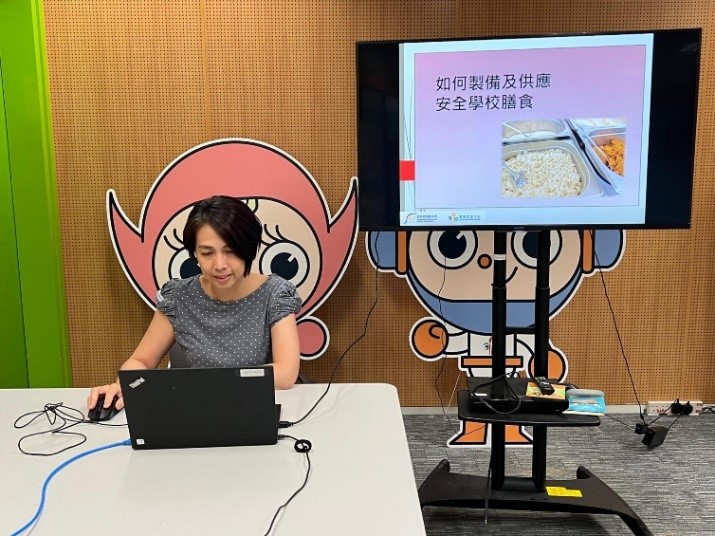
Ask Our Mascots
Codes on Imported Foods from Japan
Codes on Food Packaging Have No Relation to Foods' Origin
Several years ago, rumours had it that “some imported foods from Japan may be labelled as originating from Tokyo, but have codes in front of the expiration date indicating that the food is actually from Fukushima, Gunma, Chiba, Ibaraki or other regions”. This rumor has revived recently. However, the CFS has checked with the relevant government department of Japan and confirmed that the codes on food packaging have no relation to the foods’ origin.
Close Surveillance on Safety of Imported Food
The Government of the Hong Kong SAR will closely monitor the safety of imported food from Japan and assess the related risks to take appropriate corresponding measures. To learn the latest import control arrangements for food from Japan, go and visit: https://shorturl.at/lxzE9.
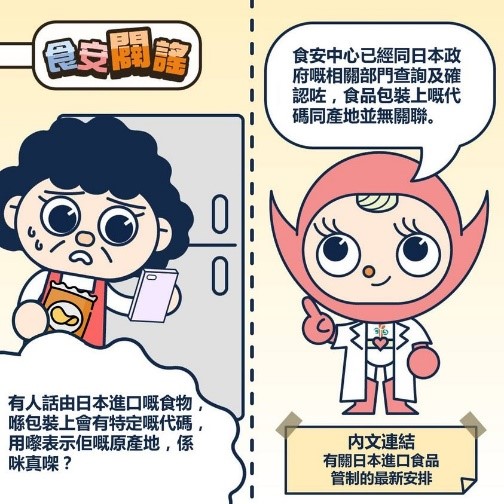
Food Safety Quiz
-
Which of the following is not one of the “Five Keys to Food Safety”?
- Choose safe raw materials
- Separate raw and cooked food
- Cook thoroughly
- Stay focused
- What minimum core temperature should be reached for food to be thoroughly cooked as recommended by the CFS?
-
45℃
- 60℃
- 75℃
- 100℃
-
- Food must be kept at a safe temperature. Which of the following is outside the safe temperature range?
-
Cold food being kept cold at or below 4℃
-
Cold food being kept cold at 10℃
-
Hot food being kept hot at above 60℃
- Hot food being kept hot at above 70℃
-
Answers:
- d
- c
- b
Diary of Mascot ON
Prevent Food Poisoning in Summer! Follow “Five Keys to Food Safety”
Bacteria are becoming more active as the weather heats up. In hot summer, the risk of bacterial food poisoning is substantially higher. With the summer approaching, you are reminded to follow the 5 Keys so that you can enjoy seasonal delicacies with peace of mind!
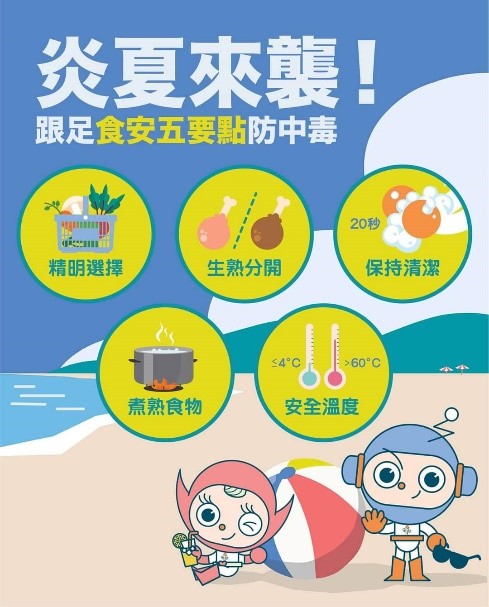
- Choose: Choose safe raw materials – Buy food from reliable shops.
- Clean: Keep hands and utensils clean – Wash hands thoroughly with water and liquid soup for at least 20 seconds before/after preparing food and before eating.
- Separate: Separate raw and cooked food – Use separate knives and chopping boards to handle raw and cooked food.
- Cook: Cook thoroughly – The core temperature of the food should reach at least 75℃.
- Safe temperature: Keep food at a safe temperature – Keep cold food cold at or below 4℃ and hot food hot at above 60℃.
In hot summer, high-risk foods should be handled with extra care and should not be kept at room temperature for a prolonged period of time. Such foods include ready-to-eat foods that generally do not require further cooking (such as siu mei and lo mei, as well as cooked rice and pasta) and raw or undercooked foods (such as oysters and sashimi). To learn more, go and visit the “Safe Food for All” thematic website: https://www.cfs.gov.hk/safefood.